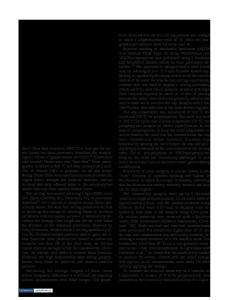Electromechanical study of carbon fiber composites
- PDF / 294,885 Bytes
- 12 Pages / 612 x 792 pts (letter) Page_size
- 98 Downloads / 374 Views
MATERIALS RESEARCH
Welcome
Comments
Help
Electromechanical study of carbon fiber composites Xiaojun Wang, Xuli Fu, and D. D. L. Chung Composite Materials Research Laboratory, State University of New York at Buffalo, Buffalo, New York 14260-4400 (Received 16 June 1997; accepted 30 January 1998)
Electromechanical testing involving simultaneous electrical and mechanical measurements under load was used to study the fiber-matrix interface, the fiber residual compressive stress, and the degree of marcelling (fiber waviness) in carbon fiber composites. The interface study involved single fiber pull-out testing while the fiber-matrix contact electrical resistivity was measured. The residual stress study involved measuring the electrical resistance of a single fiber embedded in the matrix while the fiber was subjected to tension through its exposed ends. The marcelling study involved measuring the electrical resistance of a composite in the through-thickness direction while tension within the elastic regime was applied in the fiber direction.
I. INTRODUCTION
Due to the high strength, high modulus, and low density of carbon fibers, carbon fibers are widely used as a reinforcement in composite materials. Composites utilizing carbon fibers are most commonly polymermatrix composites, although they include carbon-matrix, cement-matrix, and metal-matrix composites. Applications of these composites include those related to the aerospace, automobile, marine, construction, sporting goods, and biomedical industries. Due to the technological importance of carbon fiber composites, much fundamental research has been conducted by numerous workers on the structure and properties of these materials. Experimental techniques used for the research include mechanical testing, electrical measurements, fiber-matrix bond testing (by single fiber pull-out or push-in testing, or by single fiber fragmentation testing), microscopy, surface analysis, and thermal analysis. These techniques have their limitations. For example, microscopy and surface analysis give information on the structure of the composite, but do not provide bond strength data; fiber pull-out testing provides bond strength data, but does not give information on the structure of the fiber-matrix interface. Electrical measurements provide information on the structure, since carbon fibers are electrically conducting. However, interpretation of the results in terms of the structure is often complicated by the multiplicity of factors that affect the electrical behavior. For example, both fiber waviness (also called marcelling) and delamination affect the through-thickness resistivity of a continuous carbon fiber polymer-matrix composite laminate. Fiber waviness increases the chance that adjacent fiber layers touch one another, thereby decreasing the throughthickness resistivity. However, delamination increases this resistivity. The decoupling of these factors is difficult or impossible. Mechanical testing provides practical, J. Mater. Res., Vol. 13, No. 11, Nov 1998
http://journa
Data Loading...










